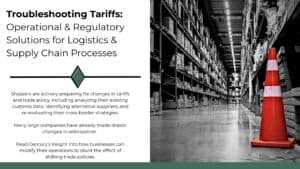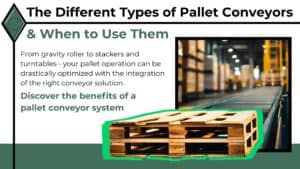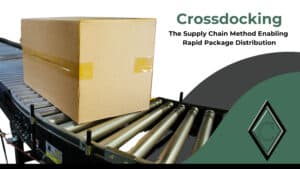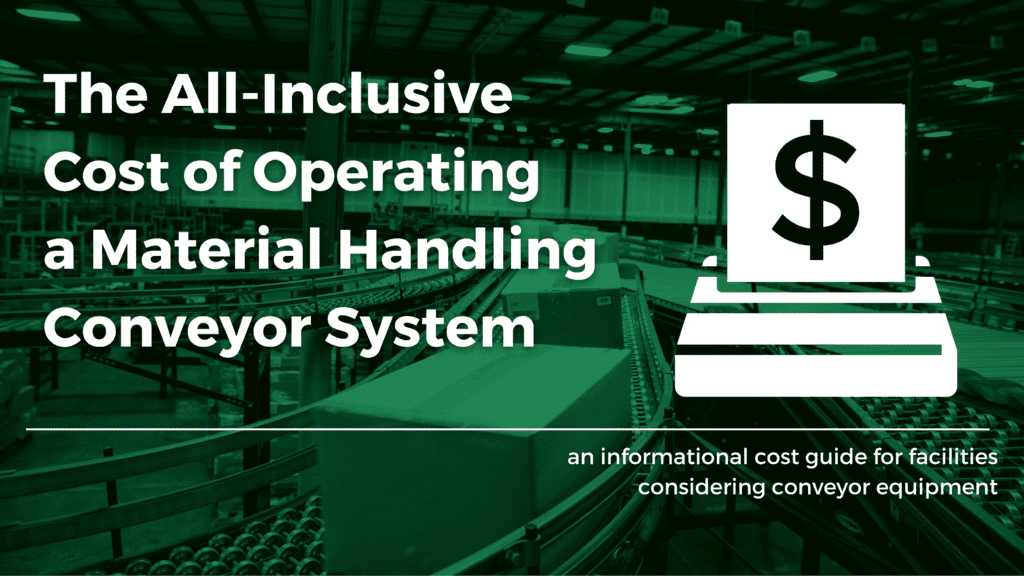
Conveyor systems are highly effective machines primarily used to transport items or packages in a warehouse or distribution center. Companies that employ conveyors in their facilities find them reliable and durable machines that exponentially decrease the time needed to process items, simultaneously increasing the number of products that can be handled. It’s no wonder many companies use them to optimize and speed up their operations.
Have you experienced exponential growth in your material handling business, and are considering integrating your own conveyor, or upgrading older equipment? While the cost of the equipment can greatly vary depending on the size and scope of your system, operating expenses are an often-overlooked topic that plays a vital role in a conveyor installation project.
Century Conveyor Systems has experience in engineering and integrating conveyor systems spanning over 40 years. Here are our recommendations for the first-time buyer, or the supply chain professional looking to research possible material handling solutions.
Complexity of system
It goes without saying that the expenses associated with a conveyor are entirely dependent on the scope and scale of the system. A simple 100ft straight powered conveyor will have drastically less overhead costs than that of a multi-line complex system. Not all units are created equal either, as costs vary between manufacturer, model, and the function of the equipment.
Sorters, for example, employ various forms of moving components to distribute product to the output destination. Rapid sortation (like shoe, cross-belt, narrow-belt and tilt-tray sorters) uses more moving parts than medium throughput solutions like push-arm and wheel-based sorters in order to achieve the high rate of sortation that they’re known for. Expect operating costs to scale proportionately with the speed of the sorting conveyor.
Employee training
Whenever a new unit or system is installed, any warehouse associate that interacts with it must be trained properly in its operation. This includes safety training as well.
Typically, when a new piece of equipment is installed, employees from the manufacturer (or the integration company) will brief employees on the do’s and don’ts of the system, their role in working with the equipment, and the optimal way to place items on the conveyor.
For example, Century installed a dual split-tray sorter for a 3PL client, and part of the validation process included briefing employees and completing test runs of the solution with them so issues can be identified in real time. For this system, small polybags had to be positioned correctly in one of the tray compartments, while larger polybags had to be laid across both trays. Placing items in the tray incorrectly could lead to jams or errors.
With any piece of equipment, safety guidelines must be communicated and followed, especially with a continuously moving piece of machinery like a conveyor. Each unit will have clearly posted warnings near dangerous pinch points, high-voltage areas, and fast-moving components. Certain sections of the equipment that should not be touched except by a certified technician are marked as so. Employees must understand all these protocols, as well as the consequences if they are not followed. Consult your conveyor integrator or manufacturer for a full list of safety requirements as it pertains to the specific equipment.
Maintenance
Just like any machine, proper maintenance must be performed for the equipment to operate as intended. If your facility staffs a maintenance team, training can be done with them either through the manufacturer or a conveyor service company (like Century). If your company does not have its own maintenance team, it’s important to schedule routine checkups BEFORE a mechanical issue is encountered. If a conveyor breaks down during operations, it may take days or even weeks to repair it depending on the type of damage. Subjecting your operations to that amount of downtime can cost thousands in lost time and profits.
Conveyors can vary in the complexity of routine repairs it needs.
Commonplace maintenance items may include:
- O-ring bands
- Belts
- Bearings
- Chains
- Sprockets
- Rollers
- Pulleys
- Oils and lubrication
More serious repairs may require a specialized conveyor technician to fix properly:
- Bed supports and transitions
- Electrical conduits and junction boxes
- Emergency buttons and pull cord switches
- Motors and reducers
- Brakes
- Clutch
- Sortation slats, shoes, arms, or trays
- Control panels and logic
- Compressed air
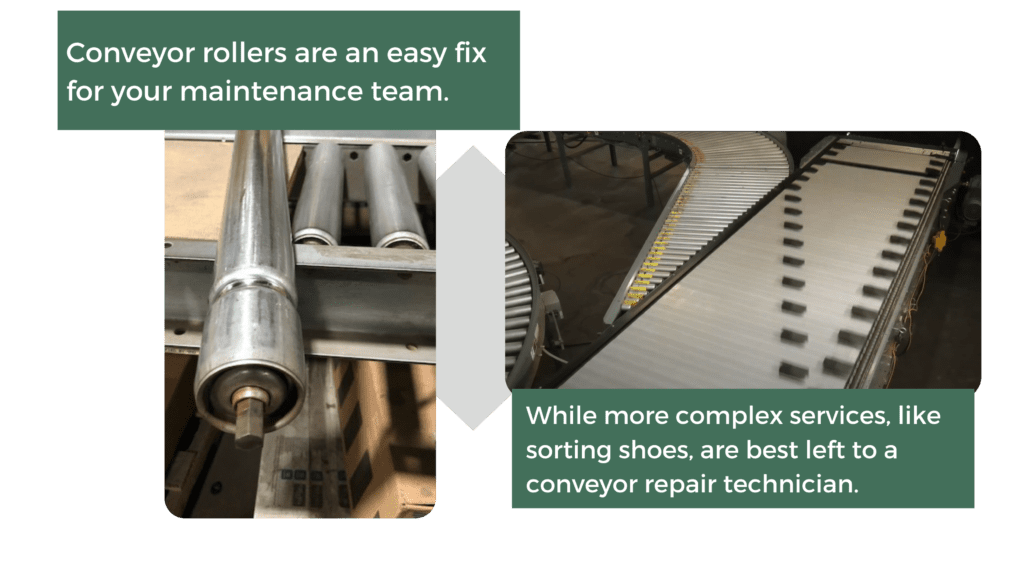
If you’re unsure about the extent of the maintenance needed on your conveyor system, it’s highly recommended to contact a certified conveyor repair service to diagnose your unit. Attempting to fix a component without a complete understanding of the repair could damage your conveyor further and render it inoperable. Conveyors are tuned exactly to the material it is handling. If the wrong part is used, or installed incorrectly, the system can damage both itself and the items that it is conveying.
It’s worth the extra cost to partner with a conveyor service company if your maintenance team is not trained in conveyor repair. Simple replacements (like singular rollers or chains) can be done without much risk, but critical components like motors and brakes should not be tampered with unless done by an experienced technician.
Uptime and Speed
To tie into the last point, the forecasted uptime, or how often and long you intend to run your conveyor system, factors greatly into maintenance. Conveyors that are required to operate 24/7 still need to be maintained, so it’ll have to be shut off at some point so work can be done. In comparison, conveyors that run only during business hours or certain shifts can have their maintenance scheduled during those off times.
With that, the more uptime a conveyor experiences, the more often it’ll wear through its parts. Our recommendation is to keep spare replacement parts on-site to avoid extended downtime. While the number varies greatly, the rule of thumb per hour of downtime for a 24/7 operation can eat up to $10,000 in lost profit.
Speed and the complexity of the conveyor section can also add to the frequency of its repairs. The average speed Century has observed in our systems is 65 CPM (cartons-per-minute), but rapid distribution operations that use certain sorters can reach up to 235 CPM.
As a real-world example, your car outputs a specific horsepower number but it’s not constantly using all that power unless you’re at full throttle. When it is at full performance for an extended period, the life expectancy of the engine and components are drastically reduced. Conveyors function much the same. Consider the flow and demand of your product, and if the conveyor system is constantly processing at that rate.
The saving grace is that conveyors are extremely durable, and manufacturers design them with continuous uptime in mind. Some conveyors can also adjust the speeds based on the information it’s receiving from the photo eyes and sensors. If no packages are detected in a block, it’ll turn off that conveyor section until product is detected in the previous block, then it’ll activate.
For more general speed and timing changes, the control settings of the entire conveyor system can be fine-tuned to match input and output. The system may be able to operate at high speeds but receiving and loading operations may not be able to match the rate (depending on the level of automation in your facility). Most truck loading operations are still manual, and it’s all too often to see a conveyor system running too quickly for worker loading, resulting in jams or packages and pallets being placed haphazardly.
This is why testing and validation is done by conveyor engineers, to exactly match the rate of product being processed. If there is a change in flow for whatever reason, a systemwide change can be done to either increase or decrease the speeds.
Controls
Installing a conveyor system isn’t as simple as plugging it into an outlet. Most industrial systems use the standard of 460v-480v and run that electricity through custom control panels to operate the equipment. Each control panel is built specifically to the design of the system and contains starters, relays, lights, switches, motors, and more to handle the distribution of electricity and system commands. Century primarily uses non-proprietary modules in its control panels (Allen-Bradley, for example), but depending on the complexity and needs +of your conveyor system specialized components may have to be used.
Existing control panels can be upgraded to compensate for any new equipment additions, while new systems will need a panel to be fabricated from scratch. Field wiring will also need to be done on-site to connect all conveyor sections and equipment to the panel. The typical control panel project can vary from $20,000 to $40,000 per panel, not including the on-site electrical labor. The more automated and intricate a system is, the more complex the control panel(s).
Warehouse Management Software
A warehouse management system, or WMS for short, is a powerful control tool that gathers various amounts of information to process tasks and prepare reports. WMS hubs offer a vast array of warehouse functions, all aggregated into an interlinked operating system. The main goal of a WMS is to monitor and manage warehouse operations involved in the movement of products and packages.
A basic warehouse management system can cost anywhere from a few thousand dollars to tens of thousands of dollars, while enterprise-level systems with more features and capabilities can cost well into the six-figure territory. More and more providers are offering platforms on a monthly subscription-based model, and charge according to the number of licenses (or users) that have access to the software.
A report from Softwarepath averages $167 per month, per user for a month-to-month WMS service. If you’re considering buying the software outright with a perpetual license, $2,500 per user is the baseline for an entry-level tier.
Set-up costs are also a factor. The mid-range expenses as observed by ExploreWMS hover around the $5,000 number. Expect this to scale proportionally to the level of automation and size of your facility operations.
Additional integrated systems
Conveyors typically aren’t the only system integrated in a project unless the operations are extremely simple. Consider the functions of your supply chain. Does your facility provide picking and packing? Storage modules (like racking and shelves) or P&A units (like carton formers or sealers) may have to be integrated in conjunction with the conveyor to make the automation cohesive. It’s entirely based on the operations that your facility completes, and the level of automation you’re implementing.
At the very least, package induction should include ergonomic material handling structures if automation isn’t being used. The most basic form of this are pack tables – platforms that warehouse associates use to either complete order fulfillment or for moving packages from a static area to a conveyor section. These tables can be outfitted with horizontal rollers or omnidirectional ball-type rollers.
To further optimize manual package handling from storage to processing, flow racking can assist operators by eliminating static shelving in favor of gravity-based skatewheel channels that move product as it’s taken off the rack. Flow channels are also available for pallets to help with staging for warehouses that use them.
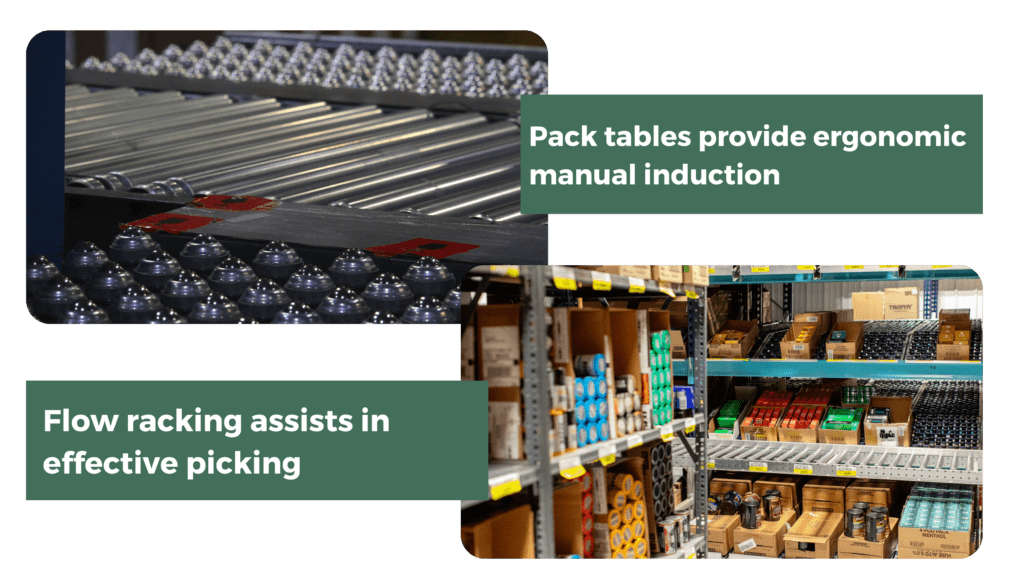
Expect to spend a few thousand dollars for these ergonomic solutions, while fully automated offerings usually start at $25,000 to hundreds of thousands of dollars. If you’re working on a tight budget, but want to automate as much as possible, the used equipment market is a viable alternative to spending on brand-new units. If going this route, Century recommends having your engineering team or a representative from the material handling integrator inspect the equipment you intend to buy to ensure it’ll slot into your system without much hassle. These units are highly customized to the original system it was designed for, so it’s imperative to do your homework before selecting a pre-owned machine. The upside of this, since the equipment is so specific, deep discounts can be found.
Summary
What’s the final cost of operating an entire conveyor system? The true answer to that question is, it depends. Every warehouse and distribution center is different, and so is the equipment that is used and the operations that are completed. It’s impossible to give an accurate number without knowing every detail.
Don’t let this scare you off from implementing a conveyor system in your warehouse, though. Material handling integrators like Century can build out systems with cost-effectiveness in mind.
Always remember, the upfront cost may be a large pill to swallow, but conveyors are known to make a speedy return on investment.
Most see a 2-to-3-year return from the launch of the system. The increased throughput and stability allows exponentially more product to be processed, which is why the turnaround is so quick.
Still curious as to what a conveyor system would cost for your facility? Request a quote from Century and our automation experts will coordinate all the details with you to provide an accurate estimate.



